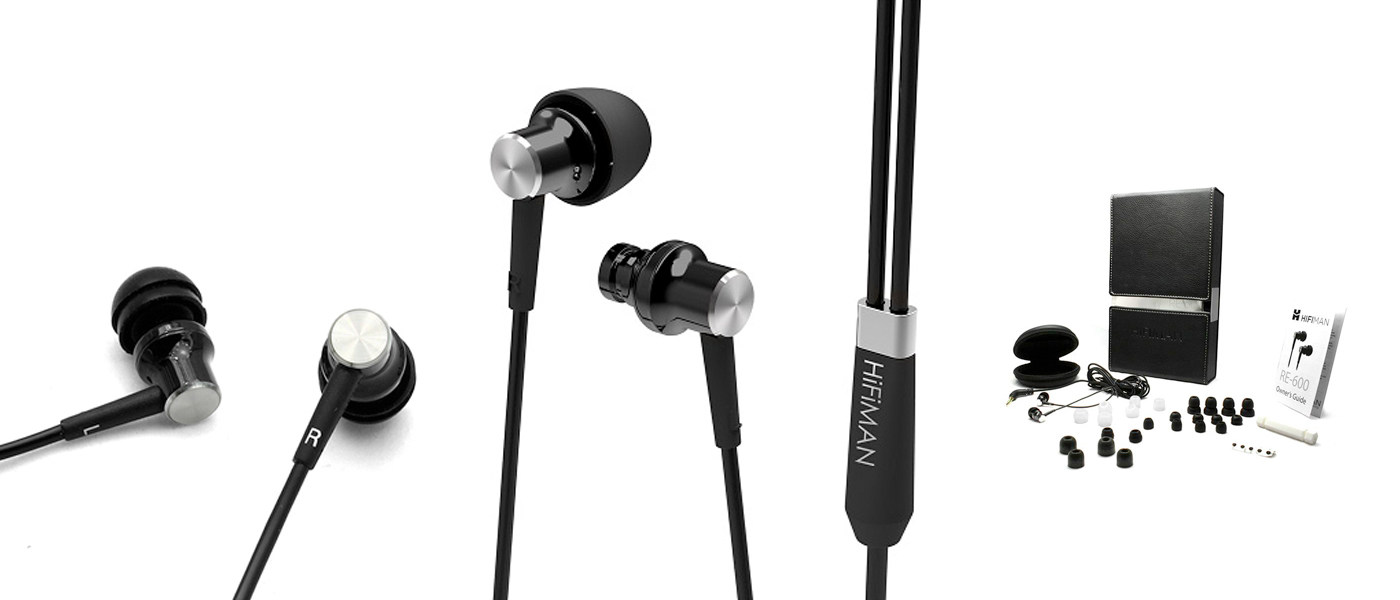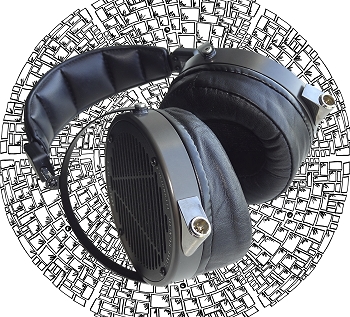

Introduction
Audeze has been a rising star in the headphone arena for several years, making their name with extremely high quality planar magnetic over-the-ear designs. Their latest model is the LCD-X, which touts a thinner diaphragm for improved transients. At $1,699, the LCD-X is one step below their best headphones, which are also planar-magnetic, the LCD-3.
SPECIFICATIONS
- Design: Planar Magnetic Over-the-Ear Headphones
- Open Back
- Diaphragm: 6.17 Inches2 Surface Area
- Magnet Structure: Neodymium
- MFR: 5 Hz – 20 kHz
- THD+N: 1% @ 20 Hz – 20 kHz
- Maximum Output: 130 dB
- Efficiency: 96 dB @ 1 mW
- Nominal Impedance: 22 Ohms
- Dimensions: Each Earpiece – 4.5″ Diameter x 2″ Thick
- Weight: 2 pounds
- MSRP: $1,699 USD
- Color: Gray with Black Leather Ear Surrounds
- Audeze
- Tags: Audeze, LCD-X, Planar Magnetic, Heaphones, Over-the-Ear, Audio
Design, In Use, On the Bench, and Rating
First of all, let’s discuss what planar magnetic means. There are three types of flat-panel speakers: electrostatic, ribbon, and planar magnetic. Planar magnetic speakers are similar to ribbon speakers, but the membrane (diaphragm) is larger on the planar magnetic speaker. It can be several inches in height and width, while the ribbon diaphragm is more likely to be 1″ wide (like a “ribbon”). Both planar magnetic and ribbon speakers work on the same principle, having a conductive diaphragm suspended in between permanent magnets, with the North pole of one magnet on one side of the diaphragm and the South pole on the other side. The diaphragm is very thin and made of plastic. It is somewhat like the plastic wrap that you use in the kitchen to wrap food to put in the refrigerator, but it is much thinner than that – so thin, in fact, that it is very delicate. This results in a driver that has extremely low mass, which is why it reproduces fine detail and very short transients so well.
Carver Amazing speakers are ribbon speakers, but actually, more accurately called “quasi-ribbon” speakers, because the conductors are printed on a thin plastic substrate rather than the ribbon being a thin metal conductive strip itself. (Originally, ribbon speakers used thin metal strips.) The word “quasi” is not generally used to describe the technology anymore. It is just ribbon speakers.
The same holds true for the planar magnetic design. A conductor is printed, using electrically conductive ink, onto the surface of the diaphragm, in the shape of a spiral, so that it resembles a conventional cone voice coil, but is flat rather than being wound around a tubular core. Very thin wires are connected to each end of the printed voice coil, which are connected to the speaker inputs. For planar-magnetic headphones, the diaphragm is only a few inches in diameter, and in the case of the LCD-X, the output wires are connected to the metal-on-film diaphragm.
The metal ink printing is a generic process that some manufacturers use. With the Audeze, they use a metal-on-film lamination which creates the diaphragm “circuit” using what they describe as a “subtractive process.” An esoteric technique that could be used, but manufacturers keep their own method secret, so I don’t know for sure if anyone does this, would be to evaporate a small sample of heated copper under vacuum onto the surface of the diaphragm, using a thin mask which is open in the shape of the conductive path. This would place a very, very thin conductor onto the diaphragm. It’s a technique that lens manufacturers use to coat the lens surfaces so that they don’t reflect light from the numerous lens elements back into the camera, which would cause a loss in contrast. They use rare earth elements (minerals), and of course, their formulas are secret.
The Audeze LCD-X has a diaphragm which has 6.17 square inches of surface area. It has an open back, and so can be considered a dipole. However, since your ears are not exposed to the sound coming out of the back, it would be more accurate to call it an infinite baffle.
The LCD-X comes with two cables. One is a standard 1/4″ phone plug (seen on the right in the photo below), and the other is for use with a balanced amplifier. It separates the ground wire for each headphone, which is necessary when using balanced amplifiers. In a balanced amplifier, both the + and the – legs are “hot”. The – leg is not connected to ground, and you cannot connect the – legs of each channel together. Each cable connects to the headphones with a locking plug. When it clicks, the connector is in place. Push the button on the side of the connector to remove it.
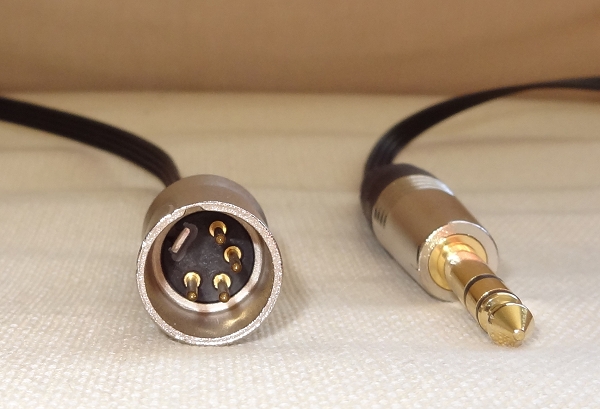
The LCD-X also comes with a very sturdy carrying case. For me, the carrying case would stay in the closet as I like to listen to headphone music in the late afternoon while I relax with a book (in the evening, when both my wife and I are in the living room, we use speakers for our relaxation music, because one pair of headphones and two people don’t match). Audeze’s custom-built travel case is an excellent way to protect your headphone investment, even if you drop it, spill liquids on it, bring it to a Head-Fi meet or the recording studio. As long as your headphones are in this case (and it’s closed), it’ll keep them safe using Department of Defense (DoD) level specifications.

I tested the LCD-X headphones using my iPod and a HiFiMAN EF5 triode amplifier with DY-1 power supply. The connection from the iPod to the amplifier was an analog RCA stereo interconnect. I also used the headphone output from an OPPO BDP-105, configured to play music from a 2 terabyte hard drive connected to the OPPO. All of my music, including 24/192 tracks, are stored on this hard drive. The headphone output of the BDP-105 is driven by two channels of its Sabre 32 DAC and two very high quality op-amps.
The soft leather surround made for a very pleasing fit, and the sliding bars allowed for easy adjustment of the length that the headphones come down on the side of your head. These are the most comfortable headphones I have tested so far.
The sound from the LCD-X was spectacular. Audeze also has this headphone with a closed back, called the LCD-XC, at $1,799. However, I believe that planar magnetic transducers should be configured as a dipole for best results. If you have a closed back, then you have to deal with the rear wave coming back at you. Nevertheless, a significant number of consumers requested a closed-back option, and that resulted in the LCD-XC.
I spent many afternoons listening to my favorite music (Baroque classical), and found it very relaxing.
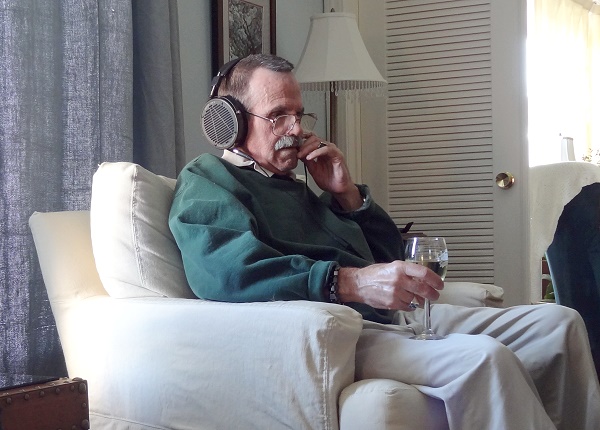
Because the diaphragm only moves about 2mm front to back, and only a watt or two is necessary to drive them, music is reproduced effortlessly, and as a result, there is almost no distortion at any frequency, even the very deep bass. I turned up the volume just a bit louder than I would ever listen to them, and still, the music flowed with no harshness or edginess that would indicate harmonics or IM. The smallest details, the shortest transients, were all a clear and well defined as I could imagine possible. Deep bass had no boominess or chestiness. There was not a hint of over-sibilance.
I could hear detail such as the mechanics of the piano keys and a squeak in the damper pedal. Unlike a conventional speaker, where the treble falls off more rapidly than the bass as you move farther away from the speaker, the treble and bass don’t fall off at all with the headphones, so you are treated to a sound that just cannot be had from any speaker.
I ran a some bench tests at 1 kHz, 10 kHz and 20 kHz just to see what the distortion spectrum looked like. I placed the tip of the microphone about 1 cm from the center of the inside of one of the ear cups. I could not seal the headphone for the tests, so the SPL numbers are probably about 10 dB less than what would be the case if the headphones were over your ears.
At 1 kHz, distortion was very low, at 0.1%. Notice that there is only a second harmonic. Shades of tube amplifiers. No wonder these things sound so good.

At 10 kHz, whoa! Pretty much the same thing. Just a second harmonic peak, with only a tiny third and fourth harmonic.
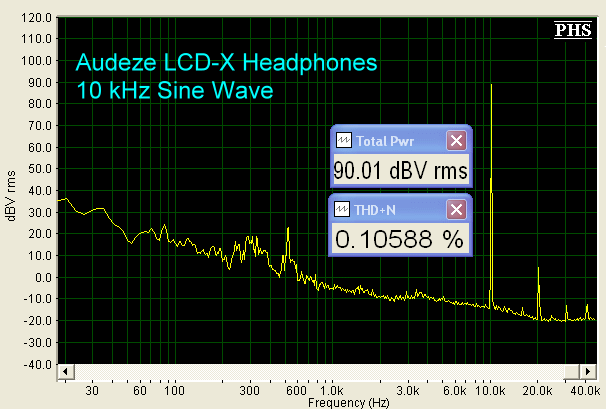
And at 20 kHz, just the second harmonic. The other peaks at 60 kHz and above are noise.
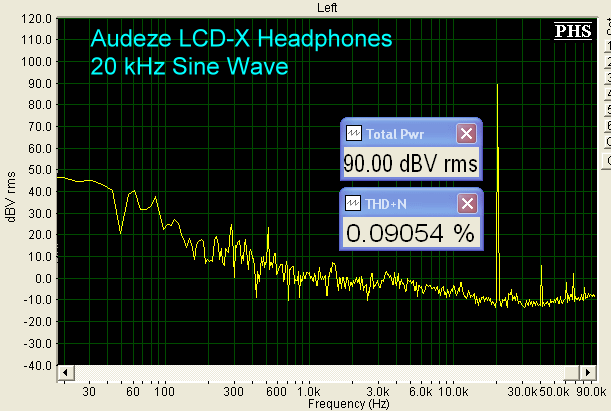
So why doesn’t everyone use headphones instead of speakers? (1) The sound stage is in your head rather than in front of you, although this is lessened in planar designs with the open back; (2) You are the only listener, so that eliminates having friends over to listen to music; (3) Long listening periods can give you a headache from the headphones pressing against the sides of your head. I should note here that because of the LCD-X’s open back design, I was able to psychologically “project” the sound stage in front of me, lessening that in-your-head effect. Also, the LCD-X had an extended depth laterally, far beyond what I was used to with typical headphones.
The sound with the EF5 triode amplifier was on the warm side, while the OPPO headphone output was very neutral, and with a bit more detail. I expected this because the DAC in the iPod is not what you would call “high End”.
I would say that this model is a bit forward in the upper bass and lower midrange, which gave the sound a very intimate feeling – more “presence”. Absolutely delightful.
The only thing I am a bit squeamish about is the price. But, then, I don’t particularly care for the price of a BMW 7000 either. On the other hand, both are worth their cost.


